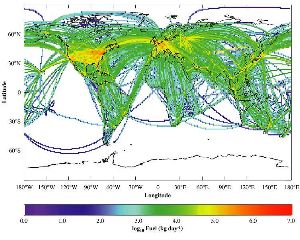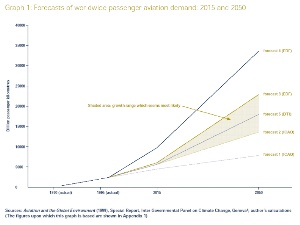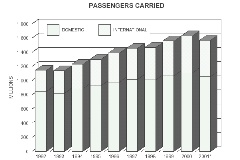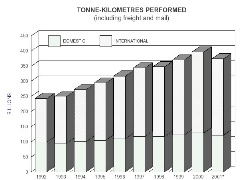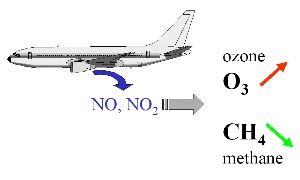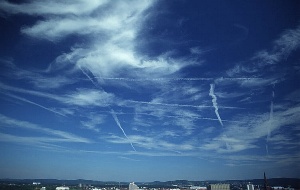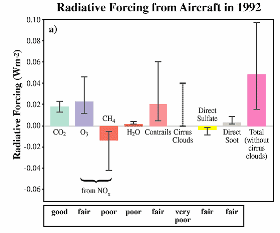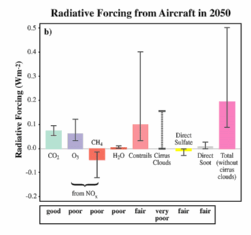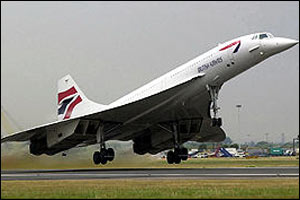 > ENC Master > Climate Encyclopaedia > Upper Atmosphere > more > 1. Dynamics & Aviation > - Aviation
> ENC Master > Climate Encyclopaedia > Upper Atmosphere > more > 1. Dynamics & Aviation > - Aviation
 |
|
|
|
Higher AtmosphereRead more |
Aviation today and tomorrowTo estimate the impact of aviation on the climate today and - more important - for the future, is a hazardous challenge. Although the influence on the climate system was of minor importance up to now, air transportation is an extremely fast growing sector of energy consumption and it is assumed, that it could be an important climate factor in the future.
|
In 2002 global revenue passenger decreased by 4%, freight by about 8%. In parallel Europe experiences an exploding market of low-budget flights and increases are predicted again for 2003. Assumptions for the next 20 years are in the range of 5% global passenger growth per year. Forecasts of aviationMany publication measure air traffic in revenue passenger kilometres (RPK = passengers times distance flown by the passengers per year). This number grew by 360% from 1970 (551 billion) to 1995 (2,537 billion). Estimations for the future vary.
|
|
|
For 2015 some predictions assume 5.700 billion, for 2050 a likely range could be 14,000 to 23,000 billions (ICAO / EDF forecasts for medium economic growth). Assuming a world population of about 10 billion in 2050 this means, that the average Earth’s citizen will go 1400 to 2300 km per year by airplane. Today, aviation makes up for about 2% of all carbon dioxide emissions from man-made sources. The contribution to the radiative forcing was estimated to be 3.5% in 1992. This is not a lot. But if current RPK will multiply in the next decades air traffic will become an important factor, contributing with 10% or more to the human induced global warming in 2050.
|
|
|
The climate impact:Aircrafts emit gases and particles directly into the upper troposphere and lower stratosphere. They alter the concentration of atmospheric greenhouse gases, including carbon dioxide (CO2), ozone (O3) and methane (CH4). They also trigger formation of condensation trails (contrails) and may increase cirrus cloudiness. All factors contribute to climate change.
|
Gas phase processesAs most other energy consuming processes, also aircraft engines consume fossil fuel and therefore produce CO2 (about 2% of all anthropogenic CO2). Moreover jet engines produce nitrogen oxides which have two major impacts in the upper troposphere: They form ozone and they indirectly destroy methane, because they lead to the formation of OH radicals, which oxidise the methane.
|
Ozone formation is a temporary local process, since the life cycle of ozone is short. An increase of about 6% in flight corridors compared to conditions without aviation is assumed for 1992. In 2050 it could be 12%. Methane depletion (about -2% in 1992, -5% in 2050)) is spread more evenly across the globe. Both, ozone and methane are greenhouse gases. On a global scale both effects nearly cancel out. On the local scale a warming by ozone formation in the flight corridors mostly on the northern hemisphere overwhelms the global cooling caused by methane depletion.
|
|
|
Water vapour, contrails and cirrus cloudsAir planes emit in the coldest region between the troposphere and the stratosphere near the tropopause. Since cold air cannot take up much water vapour, the water vapour emitted by the planes is released in a very sensible layer and easily condenses. The so called condensation trails (contrails) are formed. They can be regarded as ice clouds and can grow into cirrus clouds. Such clouds can cover 5% of the sky in the flight corridors over Europe, the US and the North Atlantic. The global contrail cover is estimated to be 0.1% and could increase to 0.5% in 2050. Contrails as cirrus clouds have a greenhouse effect, because they let most of the solar radiation pass but absorb infrared radiation from the Earth. Soot and sulphate emissions may lead to the condensation of extra cirrus cloud and add to this effect.
|
|
Level of understanding The following diagramme shows the different ways how aviation can contribute to the radiative forcing (as a measure for global warming). The scientific understanding of these impacts is partially poor to partially good depending on the impact. From the diagramme it becomes obvious, that estimations still have a high uncertainty and that predictions of the future impact can only indicate a rough range of potential values.
|
|
|
Supersonic aircraftsIn the stratosphere emissions of nitrogen oxides lead to decreases in the stratospheric ozone layer. This was an important reason that further development on a fleet of supersonic passenger aircrafts have never been really promoted. In the stratosphere exchange of gases is very slow. Significant emissions in this altitude will be spread around the globe and could have severe and hardly predictable influences on the atmospheric system and the ozone layer.
|
|
About this page:author: Elmar Uherek - Max Planck Institute for Chemistry, Mainz
|


